Alexander Hellene's Blog, page 7
December 28, 2020
Announce and Fail

In the spirit of carrying through with crazy ideas, here’s an instance where I’ve announced and failed. Multiple times. On the same project.
There is an event every February called the RPM Challenge. It’s can be thought of as National Novel Writing Month for music. The rules are to create and record either 10 songs, or 35 minutes, of original music in February. It’s also a point of pride for my Granite State-raised heart that the RPM Challenge was started in Portsmouth, New Hampshire in 2006, and has since become a worldwide phenomenon.
I’ve attempted this challenge three or four times over the years and was unable to complete it. This includes back when I (a) had tons of music gear, and (b) no kids! I even announced my participation, and I still couldn’t finish, neither the writing nor the recording. I went into it each year like a lion and meekly exited a lamb.
Problems I’ve identified include:
Perfectionism; silly for such a short time frame;
Trying to write and play songs that were above my reach, as I played every instrument.
A lack of structure in how I was going to do this.
Unwillingness to compromise or adapt and improvise in order to complete.
A lack of commitment and poor time management.
This latter is a big change from me 10 years ago and me now. It just seems like I’ve acquired more drive and not less as I’ve gotten older. Maybe because I better recognize now that there is not always time later in some undefined future to do all the things I’d like to do today. I don’t know. All I know is that I’d likely fare better now.
I mean, I used to fart around and not work on this in my free time even when I didn’t have kids. Hell, before I was married I still never finished this challenge. I was all talk and no action.
What else changed? At the risk of sounding cheesy, a lot changed in my life in the 2015-2016 timeframe, ultimately for the better though it sure didn’t seem it at the time. I had quit my job and gone back to school the year earlier, graduated, got a new job after several months of unemployment, moved away from my family, had family tragedies . . . and that was just in the fourth quarter of 2015.
However, and don’t laugh, in my desperation I sought for and came across a variety of interesting people online whose writing and encouragement spurred me to not only try and leave my impression on the world, but to make the best of whatever situation I was in and use adversity to come out stronger. I also deepened my faith in Jesus Christ by reading more and trying to live it better.
Nobody is perfect, least of all me, but it helped. This shift in mindset has led to what I like to think better things in my life and how I handle it, and that’s bled into to other realms as well.
Here’s an interesting thing to think about as well: commitment and ability to follow through in small things spills over into big things.
So maybe finishing seemingly frivolous projects like RPM Challenge or NaNoWriMo or whatever it is one enjoys doing–quilting, woodworking, blacksmithing–can have positive implications on your job, your family life, and your interpersonal relationships.
And for the record, since 2015 I did finish National Novel Writing Month twice.
Dreamers & Misfits is the fruit of finishing what I started. Buy it here.
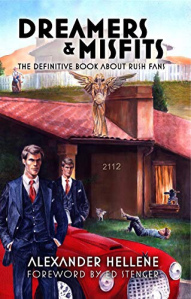
December 25, 2020
Merry Christmas!

In those days a decree went out from Caesar Augustus that all the world should be enrolled. This was the first enrollment, when Quirinius was governor of Syria. And all went to be enrolled, each to his own city. And Joseph also went up from Galilee, from the city of Nazareth, to Judea, to the city of David, which is called Bethlehem, because he was of the house and lineage of David, to be enrolled with Mary, his betrothed, who was with child. And while they were there, the time came for her to be delivered. And she gave birth to her first born son and wrapped him in swaddling clothes, and laid him in a manger, because there was no place for them in the inn.
And in that region there were shepherds out in the field, keeping watch over their flock by night. And an angel of the Lord appeared to them, and the glory of the Lord shone around them, and they were filled with fear. And the angel said to them, “Be not afraid; for behold, I bring you good news of a great joy which will come to all the people; for to you is born this day in the city of David a Savior, who is Christ the Lord. And this will be a sign for you: you will find a babe wrapped in swaddling clothes and lying in a manger.” And suddenly there was with the angel a multitude of the heavenly host praising God and saying, “Glory to God in the highest, and on earth peace, good will among men!”
When the angels went away from them into heaven, the shepherds said to one another, “Let us go over to Bethlehem and see this thing that has happened, which the Lord has made known to us.” And they went with haste, and found Mary and Joseph, and the babe lying in a manger. And when they saw it they made known the saying which had been told them concerning this child; and all who heard it wondered at what the shepherds told them. But Mary kept all these things, pondering them in her heart. And the shepherds returned, glorifying and praising God for all they had heard and seen, as it had been told them.
Luke 2:1-20
The birth of Jesus Christ took place in this way. When his mother Mary had been betrothed to Joseph, before they came together she was found to be with child of the Holy Spirit; and her husband Joseph, being a just man and unwilling to put her to shame, resolved to divorce her quietly. But as he considered this, behold, an angel of the Lord appeared to him in a dream, saying, “Joseph, son of David, do not fear to take Mary your wife, for that which is conceived in her is of the Holy Spirit; she will bear a son, and you shall call his name Jesus, for he will save his people from their sins.” All this took place to fulfill what the Lord had spoken by the prophet: “Behold, a virgin shall conceive and bear a son, and his name shall be called Emmanuel” (which means, God with us). When Joseph woke from sleep, he did as the angel of the Lord commanded him; he took his wife, but knew her not until she had borne a son; and he called his name Jesus.
Matthew 1:18-25
When Jesus was born in Bethlehem of Judea in the days of Herod the king, behold, wise men from the East came to Jerusalem, saying, “Where is he who has been born king of the Jews? For we have seen his star in the East, and have come to worship him.” When Herod the king heard this, he was troubled, and all Jerusalem with him; and assembling all the chief priests and scribes of the people, he inquired of them where the Christ was to be born. They told him, “In Bethlehem of Judea; for so it is written by the prophet: ‘And you, O Bethlehem, in the land of Judah, are by no means least among the rulers of Judah; for from you shall come a ruler who will govern my people Israel.'”
Then Herod summoned the wise men secretly and ascertained from them what time the star appeared; and he sent them to Bethlehem, saying, “Go and search diligently for the child, and when you have found him bring me word, that I too may come and worship him.” When they had heard the king they went their way; and lo the star which they had seen in the East went before them, till it came to rest over the place where the child was. When they saw the star, they rejoiced exceedingly with great joy; and going into the house they saw the child with Mary his mother, and they fell down and worshiped him. Then, opening their treasures, they offered him gifts, gold and frankincense and myrrh. And being warned in a dream not to return to Herod, they departed to their own country by another way.
Matthew 2:1-12
Merry Christmas everyone!
December 24, 2020
The Point of the Journey Is Not to Arrive (but Arriving is Nice)
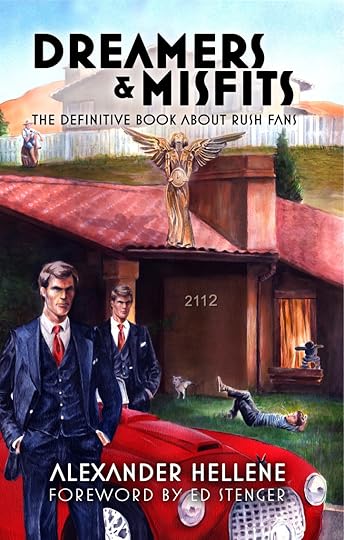
I’ve been writing a lot about Dreamers & Misfits lately, but this’ll be the last post for a while. I don’t want to talk about the book or the band, but about how immensely satisfying it is to say you’re going to do something crazy and then do it.
I announced I was going to write a book about Rush fans on February 1, shortly after Neil Peart’s untimely death, and ended up publishing on November 6. Sure, it was a bit of a diversion that distracted from finishing The Second Sojourn–which I sent to my formatter a few days ago–but there’s something to be said about carrying through with a big project.
And here’s the kicker: remember that bit of “writing advice” I penned back in April? You know, “Announce and Complete”?
Where does the “announce” part come from?
I’ll tell you: From a great form of motivation called public humiliation. Use your web presence/social media platform of choice (seriously, get a job), and announce a project. Say you will blog once a week. And then do it. Even if your post is a picture, a link to something else with a bit of commentary, or just some stream-of-consciousness writing.
Even better, announce your project, whether it be a novel or short story or what have you. Keep updating your readers. And keep plugging away at it for fear that you will out yourself as a fraud and let everybody anticipating your work down.
Wait, that didn’t help, did it?
Good. That was hyperbole for a reason. There is always a danger in burning the proverbial ships behind you. This is great motivation, though, and why I recommend that you start small.
And focus on the feeling you will get when your work is complete.
I’m sharing this to demonstrate that not only do I walk my talk–I had a lot riding on this and a lot of pressure to deliver a final product, from soliciting hundreds of fan surveys to interviewing people for the book to the IndieGoGo campaign–but I also want to show you that the Internet can actually be a great tool to help you FINISH your book and not just endlessly distract you.
Don’t discount the immense sense of accomplishment you will feel when you get that crazy idea out of your head and into the real world. And then . . . and then it’s on to the next one. And you can snag the book here.
More to come.
December 22, 2020
I Don’t Wanna Go Down!

TO THE BASEMENT!
Excellent Ramones song aside, anyone else here used to be afraid of the cellar? I know I was. Until something very specific happened when I was around six.
What made me think of this is how my little daughter was afraid of our basement until she came down with us and saw the toys and the drum set and all the other stuff. And then she was only afraid of the back rooms . . . until she saw that we could turn on the lights. Now it’s cute because she covers her eyes and smiles until the lights are turned on.
Anyway, we don’t want here down here because of possible radon, but it made me think of me being scared of our basement when I was a little guy. This was a problem, see, because the basement was where we had our Nintendo hooked up.
I’d only play with my brother because the basement was dark and cold and stuff made weird noises. I also thought that if the time ran out on a level in Super Mario Bros., the goombas and other assorted monsters would come out of the TV and get me.
Man, the sound when time got under 100 seconds freaked me out, and I hated how the music sped up.
Anyway, this arrangement worked out okay because my brother was only a year older than me and we went to school and came home at the same time. This was especially helpful when we got Castlevania II: Simon’s Quest. This game was epic–adventure, exploration–and creepy. Konami imbued all of those old Castlevania games with atmosphere to spare. And that music . . .
Oh boy, that title screen theme gave me chills. It still kind of does. No way I was playing that game alone!
Except, when I was seven and I got chicken pox from my brother and had to stay home alone.
At some point, I had played enough He-Man and done enough puzzles and read enough books. I wanted to see if I could get anywhere in Simon’s Quest, but the basement was scary and I was alone. And no, simply muting the volume never occurred to me.
So I did what any self-respecting little guy would do: I sucked it up and went to the basement by myself and fired up the game. And I’m happy to report no monsters came out of the TV to eat me.
Epic sword-and-planet that won’t come to life and eat you. Hopefully.

December 21, 2020
I’m On the Something For Nothing Podcast, plus Dreamers & Misfits Cover Trivia

The episode of Something for Nothing: A RUSH Fancast I taped last month is available today! Check it out here. I had a great time talking Rush and Dreamers & Misfits with Steve and Gerry. Great guys! Plus, it’s always cool being on a podcast I’ve been listening to for a while. Excellent stuff and I’m honored to have been a guest.
While we’re at it, let’s talk about some of the reference cover artist Jesse White put in his awesome painting:

Two “Big Money” type looking guys who live in the “Subdivison” are the first thing you’ll notice. They are standing in front of a “Red Barchetta” with a hood ornament of a rabbit popping out of a top hat like the cover of Presto.
I wonder if the car has Power Windows.
Further, these two guys look like the naked dudes from the 2112 and Hemispheres album covers. At least they finally found some clothes!
A young boy lies in the grass with one blade stuck between his teeth, staring at the sky, like “The Analog Kid.”
He, naturally, lives in unit “2112.”
A white dog–the Snow Dog from “By-Tor and the Snow Dog,” perhaps?–is relieving itself against the house evoking the pooch on the Signals cover.
An miniature inukshuk, echoing Test for Echo, stands on the doorstep.
Somebody put a stone “Clockwork Angel” on the roof to watch over everything.
Who is that boy sitting on the barrel near that freshly painted white picket fence? Could that be “Tom Sawyer”?
“Xanadu” Realty is the company selling the unit next door.
A “Limelight” illuminates a bouncing skull; someone decided to “Roll the Bones,” maybe the skull from the A Farewell to Kings cover.
And way in the distance, we can see the boy riding a missile from the “Distant Early Warning” video . . . somebody probably started a “Countdown” before launch.
And of course, the book is available here.
December 19, 2020
I Have the Power!

My kids found all of my brother’s and my old He-Man and the Masters of the Universe toys the other day.



They’re not in the best condition, and most accessories are missing, but my son loves them. He noticed what made my brother and I love these when we were younger: they’re huge and each one has a gimmick or a little thing that makes them unique.
Battle royales were set up and summarily commenced. 


What’s amazing, though, is not just the quality of these toys–and the accompanying cartoon which we fired up on YouTube (more on that later). It’s how much this franchise actually influenced me in writing The Swordbringer series.
When the idea was gestating almost ten years ago, it began of a primordial world entirely populated entirely by anthropomorphic animal-men on a blasted landscape full of ancient castles, swords and sorcery, and strange technology. This is where the character of Princess Dhaxiha came from, because I wanted a Warrior Princess.
Then I got the idea that humans could be there, voyagers from Earth long ago. That’s been done to death, of course, so I made the humans recently arrived refugees in a hostile land. But the Masters of the Universe influence remained.
Obviously, Castle Greyskull was an inspiration that’s clear to anyone who’s read The Last Ancestor, or even just seen the cover. But it was the overall vibe and aesthetic of Masters of the Universe that I wanted to emulate.
See, that old cartoon was so pulpy it hurt. It was pitch-perfect sword-and-planet full of sci-fi/fantasy adventure. And I loved how Eternia seemed like such an ancient place of desolate wastelands, deep jungles, hidden cities, high technology contending with goblin armies riding attack robots, and strangely colored skies . . . you get the picture. My planet of Yxakh is a cross between Edgar Rice Burroughs’ Barsoom and He-Man’s Eternia, with a little Thundercats thrown in.

The show actually had a young stable of up-and-coming talent writing it, and though it seems goofy it was also fun. Pure action/adventure with no annoying winking irony. Never underestimate how passionate adults crafting quality stories for kids can overcome, as was the case here, Masters of the Universe‘s origin as a cash-grabbing animated advertisement for the, admittedly awesome, toy line.
Children’s fare nowadays seems like a Peter Pan’s idea of the safe sort of anodyne stuff they think they would’ve loved as kids as opposed to stuff that didn’t condescend to kids’s desire to both be seen as, and do, cool grown-up stuff. Maybe I’m misreading a lot of it, but there is a total difference of feel that I think kids now, when exposed to the older stuff, totally feel as well.
And it’s not just the aesthetic but the attention to detail and the care.
So there you go. A kid’s show that left a deep influence no different than how the old Buck Rogers serials left an impression on George Lucas. I’m not comparing myself to George Lucas, but–
Okay, I totally am.
Check out The Last Ancestor here. And yes, the sequel is coming soon . . .

December 16, 2020
Book Review: American Psycho by Bret Easton Ellis

This was a difficult book to read. But it was also an important one. As such, this is going to be a difficult review to write. For one thing, there has almost been as much ink spilled about American Psycho as blood spilled by Patrick Bateman. Second, it’s difficult to write much about American Psycho without spoiling the entire point of it. Still, I will try.
American Psycho first came on my radar in college either in I want to say 2002. My friend Mike loved the movie, which came out in 2000, and our crew of guys would watch it, among others, laughing at Christian Bale’s creepily homicidal portrayal of Patrick Bateman and trying to figure out if it was all in Bateman’s head or if he really committed these grisly murders. One thing was for sure: the movie is as funny as it was disturbing.
I did not read the book until recently, thanks to the recommendation of my friend, writer Alexandru Constantin, who raves about Ellis’s writing. Ellis always seemed like an interesting cultural commentator, with piercing and trenchant analyses of what the hell is going on in our world, a wonderfully independent and fearless voice. It was only a matter of time before I picked up one of his novels. I always wanted to start with his debut, Less Than Zero, but at Alexandru’s urging, I picked up American Psycho instead.
I think I’m glad I did. There were parts of this book I had to skip for being too disgusting, too grisly. And yet I couldn’t stop reading it.
 Bret Easton Ellis
Bret Easton EllisAmerican Psycho takes place in the late 1980s in New York City. Patrick Bateman is a twenty-six-year-old Harvard-educated child of privilege. He is a rich, handsome, and successful investment banker at the firm of Pierce & Pierce. His life consists of wearing designer clothes, conspicuous consumption of luxury goods, going to fancy and exclusive restaurants and nightclubs, working out, listening to pop music, having sex with various “hardbodies,” and torturing and murdering people, mostly women. Bateman hangs out with Pierce & Pierce colleagues, people of similar class and taste, his best friends being David Van Patten, Timothy Price, and Craig McDermott, who are all as handsome and rich and vain as he. Others from Pierce & Pierce or other firms flit in and out of his life–Frederick Dibble, Marcus Halberstam, Paul Owen, Luis Carruthers–and they often confuse each other for someone else. This is natural, seeing as they all wear the same designer clothes, the same Oliver Peoples’ glasses, go to the same barber, and like the same things.
Women are all described as “hardbodies, blonde, big tits.” They are not people. They are objects of sexual gratification or abuse. This is one of the criticisms leveled at American Psycho, though I don’t know how anybody reading this book could think Ellis is condoning such attitudes.
Patrick is . . . different than the rest. He often has says strange things to his friends and his lovers, including his so-called girlfriend Evelyn. Things like random facts about serial killers, or the fact that he has the need to engage in homicidal behavior on a massive scale. Nobody seems to hear him, or if they do, they dismiss him as being silly. They don’t take Patrick’s confessions seriously. Should we?
It bothers Patrick, to a degree. But at night, after he and his peers have gone to the clubs, Patrick’s bloodlust needs to be satiated in order to fill the gaping emptiness in his soul. Bums are casually murdered. Call girls are copulated with on film before being brutally tortured and executed (and worse . . . oh God, so much worse). Rivals are killed. He even kills a child and feels nothing, saying it’s nowhere near as exciting as killing an adult who had accomplished a lot of stuff in his life.
The worst part, a part that even Patrick acknolwedges is pretty messed up, is that he keeps getting away with it.
Or does he?

American Psycho leaves open the question of whether Patrick is actually engaging in this homicidal behavior, or if it’s all in his mind. Because as the story unfolds, we see his murders growing more and more sadistic. And some of his encounters so absurd that there’s no way they could be real. Except sometimes . . . sometimes, some people’s reactions indicate that they know and are covering for him. But why? It’s clear that Patrick is losing his grip on sanity, if it’s not gone all ready. Did he commit all of these crimes? Some of them? Did he just wish he did? And how come nobody believes him . . . except for the people who do? Was Paul Owen REALLY seen in London?
It’s trippy stuff. But beyond this visceral look into a sick killer’s mind we have a caustic criticism of American yuppie consumer culture dripping with pure venom. Patrick and his friends are all non-entities. They mistake each other for other people all the time. Identity and the loss thereof seems to be a key theme in American Psycho. These people all define themselves not by their work in the sense that they are proud of what they do–in fact, we see them doing basically no work–but in where they work and how prestigious it is. They define themselves by what they own: Patrick’s long descriptions of what everyone is wearing, the brand names he has in his apartment, his skin care and work out regimes, his thoughts on Whitney Houston, Genesis, and Huey Lewis and the News . . . it’s as though Patrick is not there, his soul and his very being made up of material goods and what style magazines say about various things. Patrick is an endless source of fashion tips for men. He enjoys going to ATMs just to take money out and put it in his expensive wallet. He is always renting videos, mostly ultra-violent slasher flicks and hardcore pornography. In fact, “I have to return some video tapes” is a running gag, Patrick’s excuse for not hanging out with someone, or his explanation of where he was last night.
Patrick also has a large collection of guns, knives, and other implements of torture and pain. He seems particularly fond of his nailgun.
And yes, I have to discuss the elephant in the room: Patrick is obsessed with Donald Trump. I’m just putting that information there for you to do what you will with it.
This is a sick book, yes, but how different is Patrick from what we see today? The popular Internet meme of the “Consoomer” exists for a reason. These are people roundly mocked for having no personality beyond Marvel movies, comic books, video games, Star Wars and whatever slabs of homogenous pop culture Hollywood pukes up at us. Like Patrick Bateman, far too many seem to have nothing behind their eyes, no God, no spirituality, no thoughts of their own. Consume product and get excited for next product.

So it’s easy to point the fingers at others, but this is another aspect of American Psycho that disturbed me beyond the disgusting violence described: Am I that much different?
Let me put that out: Like many people, I conflate the price of something and whether I’ve heard of it with “quality.” A small example: it took years of deprogramming to just buy the damn generic brand medicine instead of shelling out far more money for the name brand, despite both having the exact same ingredients. I’m something of a brand snob when it comes to music equipment and clothes. Further, like Patrick, I could go on and on about various rock groups and the deeper meaning and significance in their work–I wrote an entire book about Rush, after all.
Do I have a void in my own being that is filled with stuff?
Maybe I do. And like Patrick Bateman, I am aware of it. Unlike Patrick Bateman, thank God, I don’t try to inflict any inner pain I might feel by murdering innocent people. But might Patrick’s mental deterioration be an extreme version of the kind of mental and spiritual deterioration we are seeing in the thirty years since American Psycho was published? People in America and large swaths of the world with a similar consumer/capitalist culture that has gone to great lengths and taken great pains to eliminate the last vestiges of Christendom–and utterly co-opt, neuter, and subvert those it couldn’t eradicate–are not well in the head or in the soul. Sickness reigns.
I jokingly wonder if the modern incel “consoomer” porn addict type of person we call “neckbeards” or whatever is this generation’s Patrick Bateman. And then I’m reminded of Elliot Rodger and it doesn’t seem so funny anymore.
American Psycho is a Godless book. Bret Easton Ellis was on to something, some raw nerve in the dark recesses of American culture, something he recognized in himself while living a similarly vapid life in the fast lane of 1980s New York City. Three decades later, this undercurrent is mainstream.
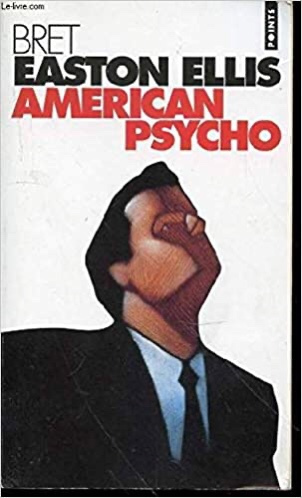
I have not yet spoken about Ellis’s actual writing. It is exquisite. He captures the emptiness in Patrick Bateman so perfectly that you want to reread entire pages even though they may fill you with a “nameless dread.” Patrick’s disassociation and detachment from reality is made clear in how most chapters begin: “I am sitting in a taxi . . .” “I am at a booth at Harry’s smoking cigars . . .” “I am at the gym . . .” When he meets someone, he spends paragraphs describing the brands they are wearing, usually followed by a reference to the topic of that morning’s (fictitious) Patty Winters Show.
Ellis’s dialogue is also perfect, realistic sounding in the way that only masters can pull off. Bateman seems normal, until he drops some weird, murderous reference with the same casual ease he drops them into his narration. Make no doubt about it, Patrick Bateman is an unreliable narrator. Can we take anything he says at face value, anything beyond the sharp, constant hell he finds existence to be?
There is no exit.
Bonus: Movie Review: American Psycho (2000)
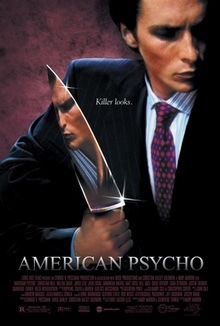
After reading this book, I decided to revisit the movie version for the first time in almost twenty years. WIth a screenplay by director Mary Harron and actress Guinevere Turner, the American Psycho movie hews very close ot the book, even using language direct from the book for the bulk of its dialogue and voice-over narration (it’s that good), albeit in different order. Some scenes are changed–in particular, Patrick’s first date with Jean, Patrick’s date with the model, the whole “chainsaw” thing which isn’t in the book, the events of the chapter called “Chase, Manhattan” are truncated, and lots of stuff is left out–but these are actually good choices that make a pretty unfilmable book into a good movie.

The thing is, the movie is nowhere near as graphically violent as the novel: there is violence and blood, but most of the actual act of killing is not shown. Second, as Ellis himself pointed out in criticising the movie, film is visual and as such the ambiguity you are left with at the end of the novel doesn’t translate as well into film; in other words, the movie leaves a far stronger impression that it’s all in Patrick’s head.

This is not to say the movie version is bad. Far from it! It’s funny. Harron turns American Psycho into a dark comedy/slasher flick, emphasizing the book’s satirical elements over the psychological ones. Christian Bale is stunningly perfect as Bateman, giving a controlled performance of a man struggling to keep it all in and pass for human . . . until his frenzy takes over. The other actors are fine as well: Willem Dafoe as Detective Kimball, Josh Lucas and Justin Theroux as two of Patrick’s louche comrades, Jared Leto as Paul Allen (who is Paul Owen in the book), Chloe Sevingy as Jean, Reese Witherspoon as Evelyn . . . the entire cast does a bang-up job. The sets recreate 1980s New York City, the fashion and music are spot on (though the same INXS song that plays in every club in the book isn’t played here), and the film has some indefinable quality that makes it eminently rewatchable. This explains why we must’ve watched it ten times in college.
I don’t know how a film with such ugly subject matter makes me want to watch it again even though I just watched it two nights ago. Maybe because it, and everyone in it, looks so good. This also explains why I absolutely see myself rereading the book at some point in the not-too-distant future.
Abandon hope all ye who enter here.
Luckily, my books are positive.

December 14, 2020
What an Uninspiring Time to Be Alive

America is an incredibly uninspiring place. We have no heroes that are worthy of admiration or emulation. We have no mythos that hasn’t been tarnished or slandered. We have no legends that have not been torn down and ridiculed. Further, the replacements have proven to be woefully inadequate and, more often than not, embarrassing.
This can partially explain why Marvel movies and other entertainment about made-up superheroes and other works of popular fiction have become like a religion to so many, mostly young, people. We hear all the time about how comic books are our modern mythology, the powers and the mighty deeds and so forth. But equating Captain America or Superman to Hercules or whomever is just ridiculous, especially considering those in charge of making our entertainment hate the very characters they are in charge of and work to undermine everything that historically made people identify with them in the first place.
Modern entertainment is a means to make money and push a particular set of morals and values. There’s nothing wrong with making money or using the arts to inculcate certain values. That’s what the arts are for. They always have been and they always will be. But the merciless commodification of what we consider our rather pathetic “modern myths” means that they will always pander to the whims of the marketplace as much as they pander to the whims of those in charge of their creation.
This wouldn’t be so bad if we actually had a common culture with a common set of myths and legends and a common set of values, like the ancient Greeks did, or the Egyptians, or the Norse, or the Anglos, or the Chinese, or the Zulu, or the Inca. But we don’t. Therefore, what is pushed on us as “inspiring” is actually utterly demoralizing to some. This is sometimes unintentional, but far more often than not this demoralization is deliberate and mean. It’s intended to rub one group’s face in the fact that they are hated and must be brought low while some other group can literally do no wrong and is to be exalted above all else. It’s modern fetishism with modern blasphemy laws that are mostly pushed by private enterprises which have outgrown the power of government to rein them in. This is mostly because the American government is as owned by giant multinationals as much as it is by foreign nations. Given the fact that this feels like more of a foreign country than actual foreign countries, it’s no wonder our myths and legends are so muddled and actively demoralizing.
Imagine living in a time of heroes and legends! A time of great art and monumental public works! A time of confidence and some sort of unity! A time when stories informed us and inspired us to be great and to overcome our challenges!

Aside from entertainment, what public figures are there to look up to? There are none. No examples to be emulated. No virtues to be inspired by. Nothing but hypocrisy, graft, corruption, and vice. Maybe it’s always been like this and people didn’t know. Maybe, but I have my doubts.
For some of us, there are still the stories of the Saints who embraced martyrdom over renouncing their Lord and Savior. Others of different faiths with their own inspiring tales. But again, in a poly-religious and actively anti-religious culture like we have now, these do not bind the greater polis together. Because there is no greater polis–we are a series of diasporas held together by the threat of force. What binds this together then? Harry Potter, I guess. Or maybe Star Wars. Perhaps it’s the Marvel Cinematic Universe. Or Game of Thrones or The Handmaid’s Tale.
I don’t even need to elaborate on how sad this is.
You might be wondering why I lament this, being a writer of fiction. That’s a really good questions because I struggle with this as well. Yes, I hope people are inspired by what I write. No, I don’t think what I write is anywhere near as important as actual myth and legend. It’s a strange place to be in, but it is what it is.
Sword and planet to inspire, not demoralize.

December 11, 2020
Book Review: Not All Fairy Tales Have Happy Endings: The Rise and Fall of Sierra On-Line as Told by the Ultimate Insider by Ken

I’m going to do that thing that lots of people, myself included, really don’t like. You know, that journalistic habit of inserting themselves into the thing they are reviewing or talking about and making the discussion about them and not the work in question. But I can’t help myself because (a) this is my personal blog, and (b) the topic of this book is incredibly near and dear to me.
You see, Sierra games were a huge part of my childhood, and dare I say it, an influence on me.
 When you saw this logo come up on your computer and heard that jingle, you knew you were in for something good.
When you saw this logo come up on your computer and heard that jingle, you knew you were in for something good.My dear, late grandfather always loved technology. In the mid-1980s he hopped on board the home computer bandwagon and learned DOS like a pro. My uncle, who is considerably younger than my father, was still living with my grandparents at the time, and he bought some games for this system, including Police Quest, Space Quest, and King’s Quest III.
He also bought Leisure Suit Larry in the Land of the Lounge Lizards when that game came out. Needless to say, once my parents figured out what that game was about, they were not pleased.
 Yes, Larry is chasing a blow-up doll. Yes, this happens in the game. No, I’m not going to tell you how Larry loses it.
Yes, Larry is chasing a blow-up doll. Yes, this happens in the game. No, I’m not going to tell you how Larry loses it.In any event, these games were mind-blowing to a five-year-old me and my six-year-old brother. Faster watching my uncle and grandfather show our father King’s Quest III–and cracking up as dad typed in some decidedly not-safe-for-work commands just to see what the game would say–my brother and I asked Papou if we could try. He, of course, said yes, and we were on our way to adventure-gaming heaven.
If you’re not familiar with Sierra’s graphical adventure games, they were the outgrowth of the old text-based adventures from the late 1970s and early 1980s. Text adventures are how they sound: you are given a textual description of the room you are in and you type commands into a parser like “Look room,” “Get shovel,” “Go north,” and so on, to accomplish some objective. Sierra’s big innovation upon their founding in 1979 was adding graphics to a text adventure, thereby creating the first graphical text adventure called Mystery House.
 The first screen of Mystery House. Groundbreaking at the time.
The first screen of Mystery House. Groundbreaking at the time.The graphics were crude, but Mystery House was a resounding success. More followed. Sierra would then add color. Amazing! But the biggest, most impactful innovation was the addition of 3-D graphics and a character you could move throughout an imaginative landscape.
To say Sierra was the king of computer games in the 1980s is a serious understatement. The amazing thing is that the company was the brainchild of a married couple in their early 20s: Ken and Roberta Williams.
 Roberta and Ken Williams
Roberta and Ken WilliamsKen learned computers, and Roberta had an imagination that spurred Ken to do unheard of things with them. When Roberta played one of the first big text adventures, Colossal Cave Adventure, it was she who got Ken to add graphics. She later got Ken to figure out how to add color–and Ken later wrote a book about creating graphics for the Apple ][. And Roberta kept coming up with new narrative possibilities for home computers, which eventually led to her asking “Why can’t we create a little guy that can walk around the screen and actually interact with things so we can show the player what they’re doing when they type commands instead of just telling them?”
Ken was the brains, and Roberta was the heart. Ken was the business guy and Roberta was the imagination woman. To say that Roberta is one of the most influential women in the history of gaming is another understatement. And to say that Ken was one of the most influential men is . . . well, you get the idea.
These games were so fun because of the care and passion that went into them. I’ll get into why this is later, but whether you’re playing the fairy-tale inspired fantasies of King’s Quest, the loving sci-fi spoofs of Space Quest, the raunchy though light-hearted Leisure Suit Larry series, the by-the-book procedurals of Police Quest, the dark and gothic Gabriel Knight supernatural mysteries, the historical Conquest duology, or the adventure/RPG hybrid Quest for Glory games, you were getting a product that was a true labor of love. From the puzzles and the plots to the graphics and the music, Sierra was always pushing the boundaries of the day’s technology while making sure the games were fun.
 King’s Quest I
King’s Quest I
Sierra did more than just adventure games, as you’ll find out in Not All Fairy Tales Have Happy Endings. But these games were what put them on the map. Personally, as a little kid who was already a voracious reader, these games taught me how to type, to think critically, to think laterally, and to think abstractly in order to solve puzzles.
Not all of these puzzles were great, however. Most gamers of this era will know what I mean by “Get glass” in Space Quest or only having three trips across the bridge in King’s Quest II.
Sierra’s games had a magic and a character that only LucasArts–makers of hits like The Curse of Monkey Island, Loom, and Maniac Mansion–came close to replicating, though some gamers say that LucasArts was the superior company. And there were, of course, pretenders: for example, the execrable Les Manley series took everything that made Leisure Suit Larry charmingly raunchy and did it wrong.
 Sierra’s Oakhurst, CA headquarters
Sierra’s Oakhurst, CA headquartersFor a time, Sierra was on top of the world. Theirs is an “overnight success” story twenty years in the making . . . and then in the space of a year, it was all over. Ken Williams was ousted from the company he started, Roberta’s design for the latest installment of the groundbreaking franchise she created were being ignored, and soon they cashed out and left. Sierra would exist as a shell of its former self before succumbing to the limbo of corporate rights purgatory, and there would be no more games. No more innovations. No more quests.
So what on Earth happened to bring this gaming juggernaut to its knees?
That’s the question Williams seeks to answer in his self-published memoir Not All Fairy Tales Have Happy Endings. Now, this isn’t an autobiography of Williams’s life, though he does get into that to the degree necessary. This is an autobiography–and an autopsy–of Sierra On-Line.
Williams begins with his hardscrabble beginnings in rural Kentucky, his subsequent move to California, and the fact that school wasn’t for him. It bored him. Ken was a doer, and he liked to learn on the job. He did spend a year in college where he got bitten by the computer bug . . . and the love bug, where he met the more affluent Roberta Heuer, who would shortly thereafter become his wife. In these early days, you see how Williams was a go-getter who refused to take no for an answer. He dreamed of being rich and successful, and his life was bent towards that goal.
This early era of the Williams’s life is fascinating because it shows how the 1970s and 1980s were an America that doesn’t exist anymore. Computers were coming into their own, our cities hadn’t become dangerous urban war zones, and our institutions weren’t yet totally corrupt and incapable of performing their core functions. Ken was a very hard worker and an autodidact, the classic Baby Boomer who worked while putting himself through computer programming school, but that doesn’t take away the fact that the economic environment was like that of a better, foreign country to my thirty-nine-year-old self. The way Williams jumped from job to job, always getting paid more, is stunning. Back in those days, you could fart and land a sweet gig.
Anyway, it was at these various business, learning coding and programming and getting to play with the latest new technologies, that Roberta discovered text adventures, inspired Ken to push the limits of the hardware, began designing games, and setting Sierra on its path to glory.
This chunk of the book is really great because you get to see Ken’s business philosophy explained fully. His inspirations were Microsoft and Walt Disney, and he envisioned Sierra as a combination of the two: a forward-thinking, envelope-pushing technology company with a diversified portfolio that encompassed the total entertainment and productivity landscape, with a strong brand identification that was synonymous for “quality.”
And it was.
The list of Sierra firsts is pretty staggering, and I also appreciated Ken’s aggressive marketing strategy. The section on the risqué text adventure Softporn–the precursor to Leisure Suit Larry–and the subsequent controversial advertisement featuring three topless attractive young ladies in a hot tub (one of them was Roberta!) is a riot.
 Williams never shied away from controversy
Williams never shied away from controversyNot All Fairy Tales Have Happy Endings doesn’t discuss the games themselves all that much, but that’s okay because it’s very entertaining to read about how Williams grew Sierra, fought various legal battles, expanded into sectors where competitors weren’t, and how running a free-wheeling young business is very different when shareholders and venture capitalists get involved.
Speaking of venture capitalists and shareholders, this is where the downfall of Sierra begins. After running through business successes and failures, most notably The Sierra Network, Sierra’s proprietary online gaming/social networking community that was years ahead of its time. Interestingly, Williams had the idea to target seniors first to see if they were interested in playing card games with other seniors around the country, and the world. They were, and other party games as well as multiplayer role-playing games followed. However, an ill-fated partnership with AT&T and a loss of control killed The Sierra Network–later renamed The ImagiNation Network–and left a sour taste in Williams’s mouth, a sense of “What if I did this differently?”
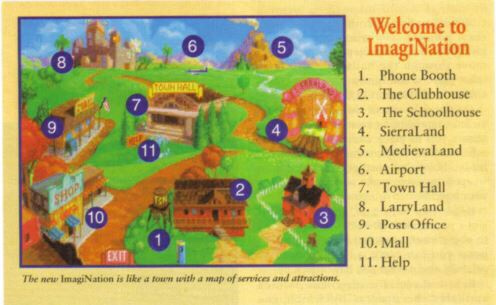 Way ahead of its time
Way ahead of its timeThere’s a lot of this sentiment throughout Not All Fairy Tales Have Happy Endings. For every Sierra success, and there were many, it seems like Williams made a decision he regrets. A merger with Brøderbund almost happened, but management styles clashed a bit too much. Here are some more:
In the early 1980s Sierra declined to get into the console video gaming market. It seemed like a good idea at the time to avoid that sector, but time has proven otherwise.
Sierra had the Ultima license but gave it up after only publishing two games (Ultima II and the awful spin-off Escape from Mount Drash).
The founders of id Software, gaming legends John Romero, John Carmack, and Tom Hall, met with Ken and Roberta and expressed their interest in selling id to Sierra. Ken declined because, while the asking price of a few million wasn’t too much, he did not want to front id the $100,000 they were asking for. Williams claims there were legal issues with providing this cash up-front, but I’m skeptical. Williams was also sensitive to the violence of Wolfenstein, but thought the game was great. So id went their own way and became super-profitable superstars when Doom hit the scene. Still, Williams did get in on the first-person-shooter genre some years later by buying Valve and publishing Half-Life, which worked out for Sierra.
Williams turned down a young Jeff Bezos’s offer to partner on automating a way to scan book covers for this thing he was working on called Amazon. Oops.
This underscores another aspect of Sierra’s business strategy that I appreciated the insights into: Williams loved buying smaller studios and letting them retain their unique cultures. These subsidiaries would design the games and Sierra would provide the same level of promotion, production, and marketing they’d give to their in-house games. This worked great, and allowed Sierra to expand into genres such as flight simulation and sports.
Further, Williams was passionate about letting his designers have relatively free reign to make the products they were passionate about. The Two Guys from Andromeda, aka Scott Murphy and Mark Crowe, made Space Quest very differently than musician/comedian Al Lowe made Leisure Suit Larry. Both were different than former California police officer Jim Walls’s Police Quest series, or Christy Marx’s historically and mythologically accurate Conquests of Camelot and Conquests of the Longbow, Jame Jensen’s supernatural Gabriel Knight series, or husband and wife Lori and Corey Cole’s epic Quest for Glory games. The rule was, if you sold a lot, you got Williams’s attention and trust . . . and you got the budget you wanted.
 Gabriel Knight: Sins of the Father
Gabriel Knight: Sins of the FatherSome games were flops. Strategy simulation Outpost was a much-hyped game that Williams greenlit on the promise of features to come that never materialized. The game was rushed for the all-important Christmas season but was nearly unplayable. Sierra’s credibility took a hit, and all of those glowing advance reviews left Sierra with serious egg on its face for perhaps the first time.
The book is full of inside stories like this. They’re instructive and fascinating. Generally, Sierra’s story is one of steady, sometimes explosive growth. The Williams’s got rich and Ken was able to live the lifestyle he fantasized about as a poor young Kentuckian. They treated their employees well, and soon the remote California mountain town of Oakhurst was a hub of activity with Sierra its main employer.
They eventually had to move to Seattle as the company grew. In order to get the top C-suite talent they wanted, they needed to be in a major metropolitan area. Things were looking up, until they weren’t. Isn’t that the way things always go?
What precipitated Sierra’s stunning, rapid collapse was the sale to Comp-u-Card (CUC), later Cendant, a giant company whose CEO Walter Forbes had been a good member of Sierra’s board since the early 1980s. Forbes was everything Williams aspired to be . . . except, perhaps, a hard worker. Williams recounts that meetings with Forbes and his inner circle involved discussing vacations and golf scores and little else.
 Walter Forbes
Walter ForbesAnyway, Forbes approached Ken and Roberta about selling Sierra to him. His offer was so good that it would have been a dereliction of duty for Williams to not even bring it up to the rest of the board. Ultimately, despite Roberta’s bad feeling about both Forbes and the deal, Williams pulled the trigger in 1997.
Sierra was essentially over by 1998.
It turned out that Forbes and much of his crew had been cooking the books and overinflating stock prices due to some “creative” accounting. This was bad enough, but the fact that Sierra became a subsidiary of Cendant, and Williams had to share CEO duties with Bob Davidson of educational software giants Davidson. Needless to say, styles did not mesh, and while Williams was promised an equal voice, Davidson was promised full power. Which he had.
At the end of the day, Ken was ousted from his own company, Roberta finished King’s Quest VIII after a tear-filled development process that would be her last, and then the Federal government got wind of Forbes and company’s shenanigans and brought the whole house of cards down. So many Sierra employees lost everything they had, a fact that eats at Williams to this day. I do not find his pain over this contrived. Ken treated Sierra and its employees like extended family, and his agony over Sierra’s demise is palpable.
Vice.com, of all places, has a great piece about the corporate fraud that killed Sierra if you want to read something that goes into a little more detail than Williams does. https://www.vice.com/en/article/z3vem8/inside-story-sierra-online-death-cuc-cendant-fraud The Vice article is somewhat of a companion to the book, and I recommend reading it in conjunction with Not All Fairy Tales Have Happy Endings, or afterwards.
At the end of the day, though, Williams made out very well for himself. He and Roberta sail around the world and seem happy, though for my money the world is poorer for not having Sierra–wonderful, free-wheeling, unique, idiosyncratic, and innovative Sierra–and its games in it.
Williams has a very conversational, easy-going style that doesn’t get bogged down in too much technical or business jargon. Nor does he belabor the points he tries to make–for such a lengthy book, Not All Fairy Tales Have Happy Endings is an easy read. Interspersed into the main narrative are what Williams calls “Interludes” where he riffs on topics he didn’t think fit anywhere else. Some, like writing code, were beyond me but I read them anyway because they gave insight into Williams’s overall management philosophy and work ethic. Others, like his approach to marketing, game designers, and the pitfalls of working with family, were easier to understand. On the whole, it’s a little chaotic and stream-of-consciousness, but it works and really lets you peek into Williams’s head. Fascinating stuff.
Not All Fairy Tales Have Happy Endings is an excellent, candid, and uncensored look into one of computer gaming’ s most legendary companies. I highly recommend this for anyone who played a Sierra game, or anyone who is interested in this period of technological history. Hopefully Ken and Roberta get the chance to make more games in some way . . . and bring some of Sierra’s legendary game designers like Crowe and Murphy, the Coles, Lowe, Marx, and Jane Jensen with them.
Before games got all corporate and samey . . . before budgets got bloated and graphics became more important than gameplay and fun . . . before designers became political crusaders and all developers chased trends and created the same thing with a different name . . . there was Sierra. And they are sorely missed.
When you’re done with this book, read my book about Rush fandom. 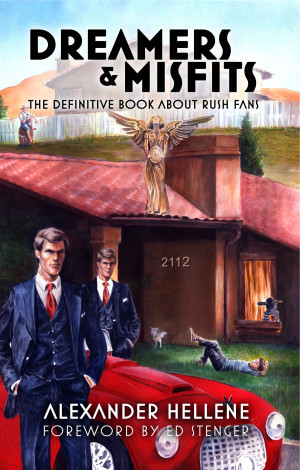
December 8, 2020
Deviate from the Norm
[image error]
If you’ve ever wondered why nothing seems to have changed culturally since the late 1990s, it’s because culturally we are still in the late 1990s, like a wriggling bug in aspic. J.D. Cowan’s recent tour de force explains many of the reasons this is so, and I recommend you read it before reading this post.
In going through Cowan’s survey, what struck me was how much deregulation coupled with the consolidation of media companies contributed to the freezing of American culture into, essentially, how it was in the 1997-1998 time frame. We see this in the passage of the Telecommunications Act of 1996, which in relevant part lifted the restrictions on national radio station ownership. Soon, conglomerates would gobble up stations, and they’d all play the same stuff.
It wasn’t all by law either. Game companies gobbled up other game companies, movie companies devoured other smaller, independent-minded movie-houses. Comic book distribution was consolidated into one company. And so on. Soon, blandness would rule the land.
[image error]
I’m being a little bit overdramatic, but for the most part this is accurate, and the trend has only increased in the past two decades. Disney seems to own nearly everything right now, and what little it doesn’t own is owned by Warner Bros. Those smaller music, movie, and literary labels that put out the interesting stuff that deviated from the norm were snatched up and then quickly forgotten unless said giant mega entertainment corporation wanted to slap the label on them to appear edgy and hip. What gets forgotten is that prior to the late 1990s, even the mainstream stuff was pretty good and interesting. Now, the perception is that things are well-produced and nice to look at, listen to, etc., but just very, very samey.
The same messages. The same style. The same people popping up over and over and over.
Worse, entertainment franchises and consumer gadget manufacturers have become religions unto themselves. The late 90s set the groundwork for the lifestyle brand.
[image error]
In Internet-speak, this the rise of the “consoomer,” but we’re adults here so we’ll try to use adult terminology.
[image error]We can still post immature memes though.
We hear about how the American middle class and its manufacturing sector has been hollowed out, if not shipped overseas. The same can be said about American culture. We exist between two extremes: the tastes of the affluent, mostly coastal urbanite, and the tastes of the ghetto. It’s the New Yorker crowd on one side and gangsta rap on the other. Not that there’s anything inherently wrong with either, but it’s that, seemingly, this is all that there is.
The reasons for this are manifold. Chief among them are that the people in control of America’s culture-producing conglomerates aren’t in it to make money. They love the money, of course, which is just how it is. But more than that, they are true evangelists of a worldview and lifestyle that they think the rest of the country–and by extension the world–should be a part of. There is no room for dissent or alternative viewpoints. Those who deviate from this norm are swiftly frozen out of further enjoying the lifestyle of the A-list creative.
I’ve said it many, may times on this website, but it bears repeating: The “freedom of speech” and “freedom of expression” battle-cries were a ruse until the self-proclaimed right people assumed control. Freedom for me, and not for thee, is the true mantra. You can let your freak flag fly as long as it’s the right kind of freak flag.
Which brings us to where we are. The Internet is the latest problem for these giant media companies. This partially explains the increasing tightening control via censorship and deplatforming.
You don’t beat moral arguments with economic arguments. And you can’t easily just “build your own.” What you have to do is play within the rules while still offering something that isn’t a copy of a copy of a copy of something that itself was a late 1990s copy of something better.
Regress harder. And look forward. We can move beyond the late 1990s and early 2000s. There’s an entire future we’ve been ignoring because we’ve been seduced by the bad kind of nostalgia.
We’re never going to recreate the past. Nor are we going to ever kill it. What we can do is use it to create something new.
[image error]
Frank Zappa said “Without deviation from the norm, progress is not possible.” And as Rush sang in “Vital Signs”:
Everybody got mixed feelings
About the function and the form
Everybody got to deviate from the norm
Mega lifestyle consumer entertainment brand is the norm. They are The Man. You don’t beat the man by doing exactly what they’re doing. You do it by finding another space, another angle . . . and you can very often find that other angle by looking where they are not.
I leave it up to you to determine where and what that is.
Speaking of Rush, now there were three men who carved out their own musical and lyrical space irrespective of what the trendmongers thought they should be doing. I wrote an entire book about Rush and why they resonated with fans so strongly. Check it out here!




